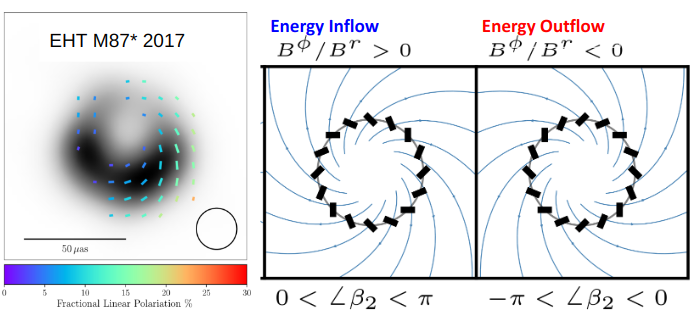See my Youtube channel for some movies of my simulations!
In the local universe, including the center of our own galaxy (Sgr A*), most supermassive black holes are surrounded by hot, thick, and dim accretion disks. Many of these black holes, like the one in the giant elliptical galaxy M87, launch relativistic jets powered by the rotational energy of the black hole itself. To understand how plasma behaves in spacetime – how it emits radiation, launches jets, and feeds the black hole – I run and analyze supercomputer simulations using the equations of General Relativistic Magnetohydrodynamics (GRMHD).
In the hot, weakly coupled plasmas around M87* and Sgr A* , protons and electrons are not in thermal equilibrium with each other. Most simulations assume thermodynamic equilibrium, so it is impossible to directly predict the radiation emitted from these simulations without making additional assumptions in post-processing. This makes connecting simulations to the near-horizon images observed by the Event Horizon Telescope difficult.


In my research, I use the massively parallel code KORAL which moves beyond standard single-fluid GRMHD to a three-fluid approximation where electrons, ions, and photons exchange energy self-consistently. This method allows us to directly predict what the Event Horizon Telescope will see at 230 GHz and understand how different models emit across the entire electromagnetic spectrum.
In Chael+ 2018a I tested two physical mechanisms for electron heating in plasmas – turbulence and magnetic reconnection – to investigate how plasma microphysics changes the images and variability of Sgr A* at different frequencies. In Chael+ 2019, I applied the same method to M87’s jet and determined that the observed characteristics are well explained by a Magnetically Arrested Disc model, where extreme magnetic fields on the black hole choke accretion.
In 2021, I was a coordinator of the paper interpreting the EHT’s first polarimetric images of M87*. We found that EHT polarimetric observations also strongly favor a magnetically arrested accretion flow.

In Chael+ 2021, I used my simulation images to examine the role of the ``inner shadow’’ in black hole images. In MAD simulations, the 230 GHz emission is nearly equatorial and extends to the black hole event horizon. As a result, the lensed image of the horizon itself is visible as a deep brightness depression in these images, but only at very high dynamic range. Measuring the size and shape of the inner shadow with the next-generation EHT will provide additional constraints on the black hole metric from future EHT observations.

In Chael+ 2023, I examined how we can use polarized images from the EHT to infer the direction of electromagnetic energy flow close to the horizon. Looking at analytic models and simulations, I found that the handedness of the polarization spiral around the black hole in M87* encodes the direction of energy flow; the EHT’s polarized image indicates that energy is flowing out from close to the central black hole. The techniques developed in this analysis could be used on future, more sensitive observations to conclusively determine if the jet in M87 is powered by the Blandford-Znajek mechanism and to measure the spin of the black hole.
In Chael+ 2017, I updated to KORAL to evolve a population of nonthermal electrons in space, time, and energy in
parallel with the thermal fluid. This represents the first time that spectral resolution of electron
distributions is possible in grid-based accretion simulations. My current work is focused on extending this method to realistic presciptions for electron acceleration and running the first global 3D simulations of black hole accretion including the spectral evolution of electrons. This method will open up new ground in understanding the nonthermal jet emission in M87 and nonthermal infrared and X-ray flares in Sgr A*.